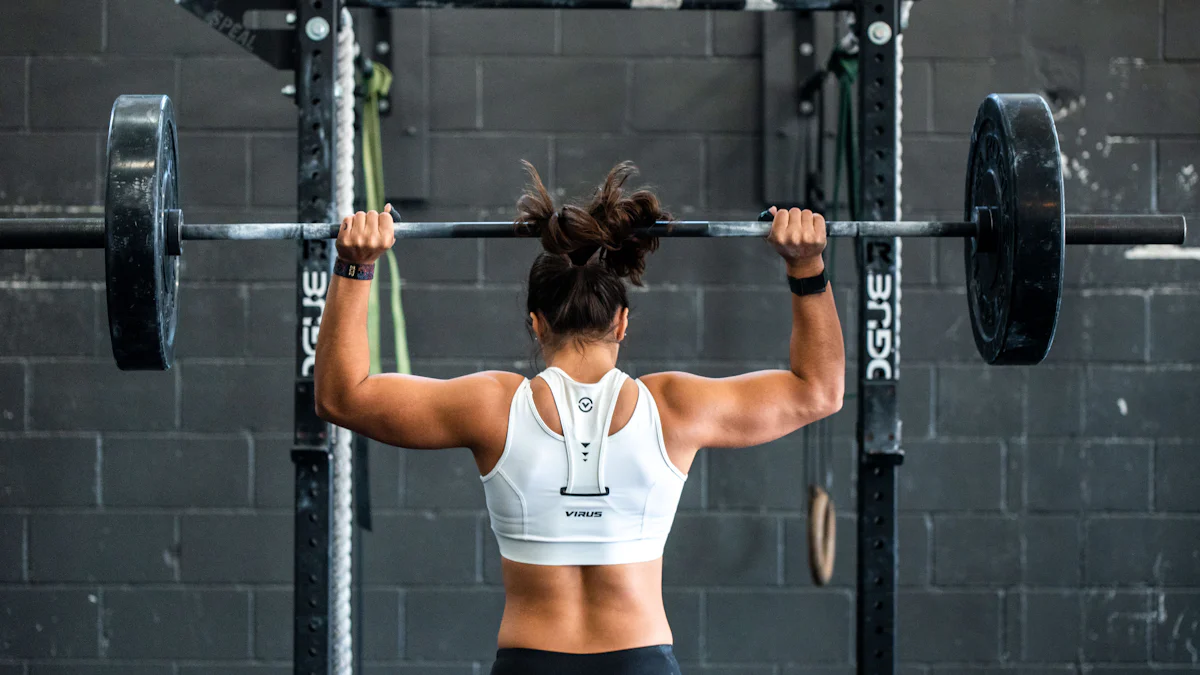
Mastering the Balance: Cardio and Weightlifting for Best Results

Finding the right mix of cardio and weightlifting can transform your fitness journey. Cardio boosts heart health and endurance, while weightlifting builds strength and burns fat. Imagine combining these benefits for a powerful workout routine. You can achieve optimal results by mastering how to balance cardio and weightlifting for optimal results. This balance not only enhances performance but also supports long-term health. Ready to unlock your potential? Let’s dive into the perfect blend of cardio and strength training.
Understanding Cardio and Weightlifting
Definitions and Differences
What is Cardio?
Cardio, short for cardiovascular exercise, gets your heart pumping. Activities like running, cycling, and swimming fall under this category. Cardio improves heart health and boosts endurance. Regular cardio helps prevent heart disease and diabetes. Cardio also aids in weight management by burning calories.
What is Weightlifting?
Weightlifting involves lifting weights to build strength. This exercise targets specific muscle groups. Weightlifting increases muscle mass and speeds up metabolism. It burns more fat over time. Strength training also enhances bone density and mental health.
Benefits of Each
Benefits of Cardio
Cardio offers numerous health benefits. It strengthens the heart and lungs. Cardio reduces the risk of several diseases, including osteoporosis and colon cancer. Regular cardio also improves mood and energy levels. Many people find cardio enjoyable and stress-relieving.
Benefits of Weightlifting
Weightlifting provides long-term health advantages. It boosts physical functioning and glucose metabolism. Weightlifting helps maintain a healthy body weight. It also improves cardiovascular risk factors. The American College of Sports Medicine highlights increased metabolism and fat burning as key benefits. Weightlifting leads to higher EPOC (excess post-exercise oxygen consumption) levels, which means more calories burned after workouts.
How to Balance Cardio and Weightlifting for Optimal Results

Strategies for Effective Balance
Incorporating HIIT Workouts
High-Intensity Interval Training (HIIT) offers a fantastic way to blend cardio and weightlifting. HIIT involves short bursts of intense exercise followed by rest. This method maximizes calorie burn and muscle engagement. You can perform exercises like burpees, jump squats, or kettlebell swings. These exercises elevate heart rate and build strength simultaneously. HIIT workouts provide a time-efficient solution for busy schedules. You can achieve great results with just 20 to 30 minutes of HIIT.
Alternating Training Days
Alternating training days helps balance cardio and weightlifting. You can focus on cardio one day and weightlifting the next. This approach allows muscles to recover while maintaining an active routine. Alternating days reduces the risk of overtraining injuries. You can also prevent workout monotony by switching activities. A typical week might include three days of strength training and two days of cardio. This schedule supports both muscle gain and endurance improvement.
Setting Realistic Goals
Weight Loss Focus
Weight loss requires a strategic approach. You can prioritize cardio sessions to burn calories. Cardio activities like running or cycling increase heart rate and aid in fat loss. You should aim for at least 150 minutes of cardio per week. Combining cardio with light weightlifting enhances metabolism. You can reduce rest periods between sets to boost calorie expenditure. This combination accelerates weight loss while preserving muscle mass.
Muscle Gain Focus
Muscle gain demands a different strategy. You should emphasize weightlifting to build strength. Lifting heavier weights with fewer repetitions promotes muscle growth. You can incorporate compound exercises like squats and deadlifts. These exercises engage multiple muscle groups for optimal results. Cardio remains essential for muscle recovery and endurance. Light cardio after weightlifting increases blood flow to muscles. This practice aids in recovery and supports muscle development.
Creating an Effective Workout Schedule

Designing a workout schedule that balances cardio and weightlifting can transform your fitness routine. You need to consider your goals, preferences, and lifestyle. A well-structured plan helps you achieve optimal results.
Designing a Weekly Plan
Incorporating Cardio Sessions
Cardio sessions boost heart health and burn calories. You can choose activities like running, cycling, or swimming. Aim for at least 150 minutes of cardio each week. Spread these sessions across different days to maintain energy levels. Cardio after weightlifting can aid recovery by increasing blood flow to muscles. This combination enhances both endurance and strength.
Incorporating Weightlifting Sessions
Weightlifting builds muscle and increases metabolism. Focus on compound exercises like squats and deadlifts. These exercises engage multiple muscle groups. Plan three days of strength training each week. Alternate muscle groups to allow recovery. This approach prevents overtraining and supports muscle growth.
Adjusting for Individual Needs
Listening to Your Body
Your body provides signals about what it needs. Pay attention to fatigue, soreness, or lack of progress. Rest when necessary to avoid injuries. Modify workouts based on how you feel. Flexibility in your routine ensures long-term success.
Modifying for Progress
Progress requires regular adjustments. Increase weights or intensity as you grow stronger. Change exercises to challenge different muscles. Track your progress to identify areas for improvement. This strategy keeps you motivated and engaged.
Combining cardio and weightlifting offers numerous benefits. You improve aerobic fitness and muscular strength. Mixing these exercises reduces the risk of overtraining injuries. A balanced approach leads to better overall health and fitness.
Practical Tips for Success
Nutrition and Recovery
Importance of Diet
Fueling your body with the right nutrients can make a big difference in your fitness journey. A balanced diet supports both cardio and weightlifting efforts. You need to consume enough protein to build and repair muscles. Carbohydrates provide energy for those intense workouts. Healthy fats support overall health and hormone production. Hydration plays a crucial role too. Water helps regulate body temperature and lubricates joints. Proper nutrition ensures you have the energy to perform at your best.
Performance Optimal Health emphasizes, “Recovery after a workout often gets overlooked, especially when it comes to meals.”
Eating the right foods post-workout aids recovery and muscle growth. Consider including lean proteins, whole grains, and plenty of fruits and vegetables in your meals. These foods provide essential vitamins and minerals. A well-rounded diet enhances performance and supports long-term health goals.
Recovery Techniques
Recovery is just as important as the workout itself. Your muscles need time to repair and grow stronger. Incorporate rest days into your routine to prevent overtraining. Stretching and foam rolling help reduce muscle soreness. Light activities like walking or yoga promote blood flow and aid recovery. Sleep plays a vital role in muscle repair and overall well-being. Aim for 7-9 hours of quality sleep each night. Adequate recovery leads to better results and reduces the risk of injury.
Staying Motivated
Tracking Progress
Tracking progress keeps you motivated and focused on your goals. Keep a journal or use fitness apps to record workouts and achievements. Note improvements in strength, endurance, or body composition. Celebrate small victories along the way. Seeing how far you’ve come boosts confidence and encourages consistency. Regularly reviewing progress helps identify areas for improvement. Adjust your routine as needed to continue making gains.
Overcoming Plateaus
Plateaus happen to everyone at some point. Your body adapts to routines, making progress slow down. Change up your workouts to challenge your muscles in new ways. Try different exercises or increase weights and intensity. Set new goals to reignite your motivation. Remember that plateaus are a natural part of the process. Stay patient and persistent. Consistency and variety in your routine will help you push through and reach new heights.
Balancing cardio and weightlifting requires dedication and strategy. By focusing on nutrition, recovery, and motivation, you can achieve optimal results. Embrace the journey and enjoy the benefits of a well-rounded fitness routine.
Common Mistakes and How to Avoid Them
Overtraining
Signs of Overtraining
Overtraining can sneak up on you. Fatigue hits hard. Motivation drops. Sleep becomes restless. Injuries seem more frequent. These signs mean your body needs a break. Ignoring them leads to burnout.
Prevention Strategies
Balance workouts with rest. Schedule rest days. Listen to your body. Mix high-intensity with low-intensity sessions. Keep workouts varied. Enjoy activities outside the gym. A balanced approach keeps you strong and healthy.
Neglecting One Form of Exercise
Importance of Balance
Focusing on only cardio or weightlifting limits progress. Cardio boosts heart health. Weightlifting builds strength. Both are essential. Balance creates a well-rounded routine. You gain endurance and muscle.
Tips for Integration
Blend both forms into your week. Alternate days. Try HIIT for a mix. Track your progress. Adjust based on goals. Stay flexible. Enjoy the variety. Balance leads to better results and keeps workouts exciting.
Remember the journey is personal. Like the story of someone who started small but grew stronger with balance. Consistency and variety make all the difference.
Balancing cardio and weightlifting transforms your fitness journey. You gain strength, improve heart health, and burn calories efficiently. Embrace the strategies shared to create a well-rounded routine. Consistency and variety lead to better results. Enjoy the benefits of a balanced approach. Remember, every step forward counts. Keep pushing, stay motivated, and achieve your fitness goals.


